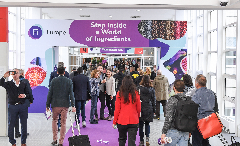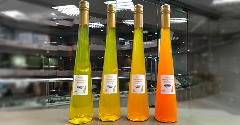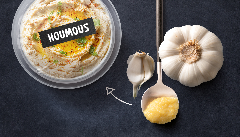News
Cochineal Sets an Example to us All
1 Sep 2014If we look at history, the aesthetic aspects of food were not a major consideration until relatively recently, and began to change fundamentally with the onset of the Industrial Revolution. (Today, for example, a Spanish paella rice dish would be unacceptable to any Spaniard without the saffron yellow coloring. My grandmother would send it back to the kitchen). From […]

If we look at history, the aesthetic aspects of food were not a major consideration until relatively recently, and began to change fundamentally with the onset of the Industrial Revolution. (Today, for example, a Spanish paella rice dish would be unacceptable to any Spaniard without the saffron yellow coloring. My grandmother would send it back to the kitchen).
From the early nineteenth century, a trend developed to add substances to food for cosmetic reasons, including an increasing list of additives – many of which resulted in significant health hazards. In recent decades, we have seen a movement to combat the adulteration of foods with colorants containing heavy metals, dangerous organic and inorganic elements and so on. The 20th century, with improved chemical analysis and deeper awareness, has led to the “positive listing”, indicating the substances that meet the criteria for human consumption.
Today’s concern, however, right after consumer protection, should be the environment, through the use of natural, non-toxic and biodegradable substances. In the world of edible insects, we find the Dactylopius coccus – better known as cochineal, source of one of the few water-soluble red colorants to resist degradation with time, and also one of the most light- and heat-stable and oxidation-resistant of all the natural organic colorants. It is even more stable than many synthetic food colors.
So here it is, “cochineal”, the source of carmine red. This little soldier from nature offers its magic with little to no direct ecological footprint compared to other reds, whose cultivation and processing can require prime land usage, fertilizers, pesticides and significant water. On the other hand, our champion’s natural habitat is desert to semi-desert land in underdeveloped areas, with cactus as its host. Cochineal’s carminic acid is the ideal candidate for the food industry to compensate, in an eco-friendly way, for color variations and loss due to light, air, extremes of temperature, moisture, and storage conditions in its capricious marketing war.
After taking into consideration dietary practices, religious beliefs and dealing with possible allergies the same way as any other allergen, cochineal, with today’s industrial challenge of feeding the world without destroying the planet, could contribute to the increasing food colorant additive demand in a responsible way.
The key drawback, which is psychological, would be cochineal’s major challenge – the insect- sourced “yuck factor“, mostly driven by a lack of knowledge, custom and information by the general public.
In the FDA’s Defect Levels Handbook, insect parts are considered as one of the natural or unavoidable defects in food production that present no health hazards for humans – yet nobody seems to stop consuming chocolate, peanut butter, marmalade, tomato sauce – or wine, for that matter – where insect parts are frequently present.
Every trend has its consequences for the global environment. The current pace of food consumption calls for better understanding of the issues rather than a simple impulse of disgust for alternative solutions. Above all, we must make sure that the other options on the table avoid becoming part of the problem, by taking into consideration arable land, water depletion, carbon food print and other key factors.
Related news

Sustainability meets innovation at Fi Europe 2023's Sustainability Ingredients Zone
9 Jan 2024
Fi Europe’s Sustainable Ingredients Zone showcases ingredients forging a path toward a greener future. Three innovators are redefining what sustainability within the food and beverage industry means, with upcycled products, regenerative agriculture, an...
Read more
Unleashing the power of plants at Fi Europe’s New Product Zone
5 Jan 2024
In the diverse landscape of plant-based innovation, Fi Europe 2023's New Product Zone spotlighted ten plant-based ingredients, tailored to meet the rising demand for sustainable and delicious options.
Read more
Meet the innovative ingredients showcased at Fi Europe’s New Product Zone
3 Jan 2024
The Food Ingredients category at Fi Europe’s New Product Zone featured 19 distinct and innovative products. From fermented delights to sustainable proteins, these ingredients are ready to make their mark in the market.
Read more
Fi Europe’s New Product Zone elevates the nutrition of everyday indulgences
22 Dec 2023
At Fi Europe 2023's New Product Zone, eight health ingredients, each offering an enhanced nutritional profile of various products, were on display. These ingredients address the evolving needs of the food and beverage industry and cater to consumers se...
Read more
Fi Europe’s New Product Zone explores fresh possibilities with five natural ingredients
20 Dec 2023
Fi Europe 2023's New Product Zone unveils five natural ingredients, each catering to the growing demand for clean products and embodying ethical and sustainable choices for today's conscious consumers.
Read more
Water-conscious consumers, upcycled food, and tech-driven sustainability: Highlights from Fi Europe, part 2
14 Dec 2023
With climate change becoming a tangible reality, consumers’ environmental concerns are changing. At Fi Europe, market analysts revealed how people are now interested in everyday issues like water shortages and tech-driven solutions such as GM drought-r...
Read more
The food industry’s single-use packaging problem
12 Dec 2023
The food industry’s reliance on single-use packaging is a sustainability “sticking point” with viable alternatives not widely available – but new EU rules mean food businesses will remain responsible for the collection and disposal of the packaging the...
Read more
Snack trends, ingredient claims, and plant-based perceptions: Highlights from Fi Europe 2023, part 1
7 Dec 2023
Value-led snacking, sustainability storytelling, and the importance of having a ‘star ingredient’: we asked consumer analysts and market experts at Fi Europe about the trends and innovations that are shaping the food industry.
Read more
HELM and Allied Biotech partnership make possible natural crystal-clear colours
7 Nov 2023
As one of the leading Carotenoid producers, Allied Biotech has successfully launched the clear colour product lines. The new products are mainly used in transparent applications. Clear colours are ideal candidates for replacement of the artificial colo...
Read more
Impact taste in your recipe substantially - through Chilled-Fresh ingredients
29 Sep 2023
Bresc is the European pioneer of Chilled-Fresh ingredients for culinary professionals that has its origins in French Cuisine. While focusing on best raw materials choice, Bresc’s recipes are conceived to inspire product development and to add-up in tas...
Read more